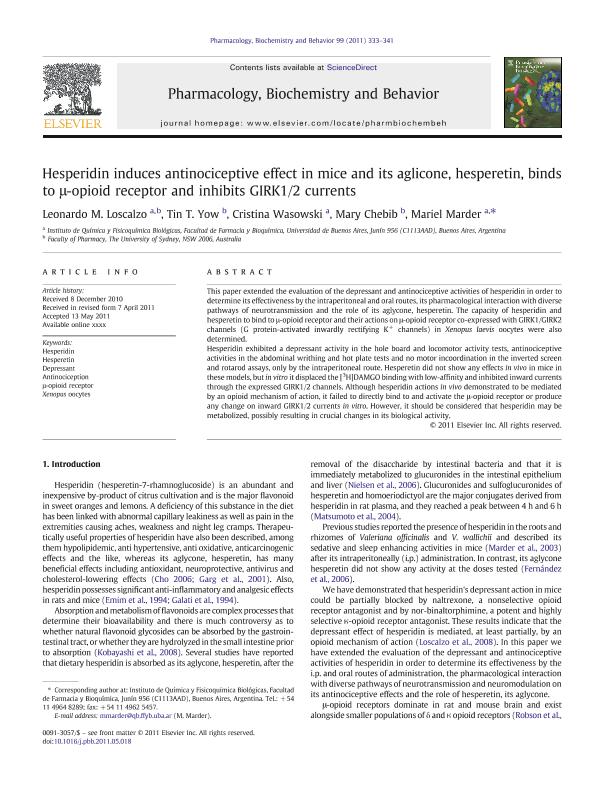Artículo
Hesperidin induces antinociceptive effect in mice and its aglicone, hesperetin, binds to mu-opioid
Loscalzo, Leonardo Martin ; Yow, Tin T.; Wasowski, Cristina Lucia N.
; Yow, Tin T.; Wasowski, Cristina Lucia N. ; Chebib, Mary; Marder, Nora Mariel
; Chebib, Mary; Marder, Nora Mariel
 ; Yow, Tin T.; Wasowski, Cristina Lucia N.
; Yow, Tin T.; Wasowski, Cristina Lucia N. ; Chebib, Mary; Marder, Nora Mariel
; Chebib, Mary; Marder, Nora Mariel
Fecha de publicación:
09/2011
Editorial:
Elsevier Inc
Revista:
Pharmacology Biochemistry And Behavior
ISSN:
0091-3057
Idioma:
Inglés
Tipo de recurso:
Artículo publicado
Clasificación temática:
Resumen
This paper extended the evaluation of the depressant and antinociceptive activities of hesperidin in order to determine its effectiveness by the intraperitoneal and oral routes, its pharmacological interaction with diverse pathways of neurotransmission and the role of its aglycone, hesperetin. The capacity of hesperidin and hesperetin to bind to μ-opioid receptor and their actions on μ-opioid receptor co-expressed with GIRK1/GIRK2 channels (G protein-activated inwardly rectifying K+ channels) in Xenopus laevis oocytes were also determined. Hesperidin exhibited a depressant activity in the hole board and locomotor activity tests, antinociceptive activities in the abdominal writhing and hot plate tests and no motor incoordination in the inverted screen and rotarod assays, only by the intraperitoneal route. Hesperetin did not show any effects in vivo in mice in these models, but in vitro it displaced the [3H]DAMGO binding with low-affinity and inhibited inward currents through the expressed GIRK1/2 channels. Although hesperidin actions in vivo demonstrated to be mediated by an opioid mechanism of action, it failed to directly bind to and activate the μ-opioid receptor or produce any change on inward GIRK1/2 currents in vitro. However, it should be considered that hesperidin may be metabolized, possibly resulting in crucial changes in its biological activity.
Archivos asociados
Licencia
Identificadores
Colecciones
Articulos(IQUIFIB)
Articulos de INST.DE QUIMICA Y FISICO-QUIMICA BIOLOGICAS "PROF. ALEJANDRO C. PALADINI"
Articulos de INST.DE QUIMICA Y FISICO-QUIMICA BIOLOGICAS "PROF. ALEJANDRO C. PALADINI"
Citación
Loscalzo, Leonardo Martin; Yow, Tin T.; Wasowski, Cristina Lucia N.; Chebib, Mary; Marder, Nora Mariel; Hesperidin induces antinociceptive effect in mice and its aglicone, hesperetin, binds to mu-opioid; Elsevier Inc; Pharmacology Biochemistry And Behavior; 99; 3; 9-2011; 333-341
Compartir
Altmétricas



